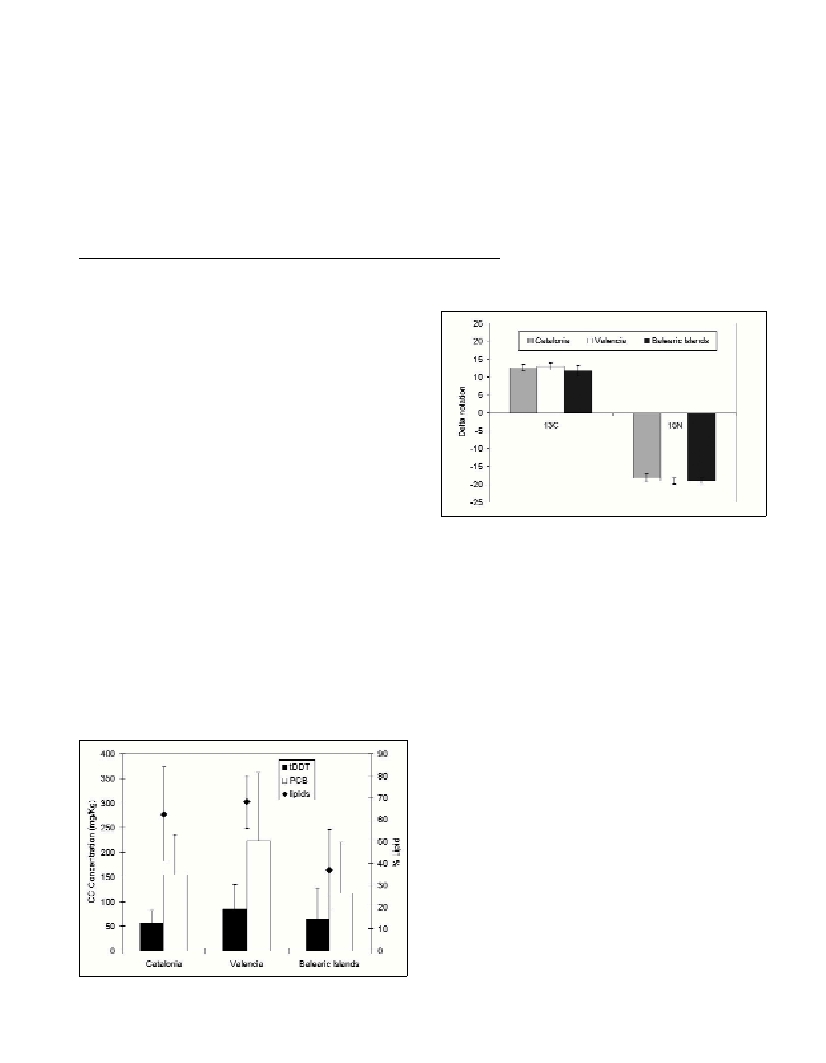ORGANOCHLORINE COMPOUNDS AND STABLE ISOTOPES DO NOT SUPPORT SEGREGATION
BETWEEN WESTERN MEDITERRANEAN BOTTLENOSE DOLPHIN SUBPOPULATIONS
A. Borrell
1
, A. Aguilar
1
*, V. Tornero
1
, G. Fernandez
2
and F. Alegre
3
1
Dept of Animal Biology, University of Barcelona, Barcelona, Spain
2
Marineland-Mallorca. Calvià, Spain
3
CRAM, Marine Animal Rescue Center, Premià de Mar, Spain
Summary
To study the population structure of bottlenose dolphins and potential isolation of subpopulation units in the western Mediterranean, we
investigated geographical variation in isotopic patterns (
d
13
C and
d
15
N) and concentration of organochlorine (OC) compounds (PCBs,
DDTs, and HCB) present in the body tissues of bottlenose dolphins (Tursiops truncatus) from different regions: Catalonia, Valencia and
the Balearic Islands. No significant (P>0.05) differences were observed neither in the OC concentrations,
d
13
C,
d
15
N nor in PCB profiles,
thus giving no support to the existence of long-term segregation between the investigated putative subpopulations.
Keywords: Bottlenose dolphin, Mediterranean Sea, Organochlorines, Stable isotops
Rapp. Comm. int. Mer Médit., 37,2004
316
Introduction
In mammals, 90% of organochlorine intake is via food, for which
reason their pollutant profile re?ects that of the waters in which they
live and feed. Therefore, populations inhabiting different geographical
areas tend to show qualitatively and quantitatively different pollutant
loads. In this study we determined stable isotopes and concentration
and profile of the PCBs present in the blubber of bottlenose dolphins
inhabiting different areas in the western Mediterranean with the aim
of investigating regional variation and improving understanding on
population structure.
Material and methods
Stranded bottlenose dolphins from the Mediterranean coasts of
Spain [Catalonia (n=8), Valencia (n=10), Balearic Islands (n=7)] were
sampled in 1990-2000. Sex and length of the individuals were
recorded. Organochlorine compounds were measured in blubber by
gas chromatography and electron capture detection. Concentrations
were expressed as mg/kg calculated on the basis of extractable fat.
Stable isotopes were analysed by EA-IRMS (elemental analyser
isotope ratio mass spectrometry) in skin; results were expressed in
standard
d
notation relative to carbonate PeeDeeBelemnite and
atmospheric nitrogen, where:
d
13
C or
d
15
N(‰) =(R
sample
/R
standard
)-1)X1000) and R=(
13
C/
12
C) or
(
15
N/
14
N), respectively.
Data were tested for normality with a Kolmogorov-Smirnov test of
goodness of fit. As the data distributed normally, differences in lipid
content and organochlorine compounds were examined between
groups using analysis of variance (ANOVA). Discriminant analysis
was used to test the significance of multivariate differences in PCB
patterns (relative abundance of the various congeners in relation to the
tPCB) between groups. All calculations were carried out using SPSSX
statistical package.
Results and discussion
Figure 1 shows the mean and the standard deviation of the percen-
tage of lipid extraction and organochlorine concentrations in blubber.
Figure 2 shows the mean and the standard deviation of
d
13
C and
d
15
N
in the skin of bottlenose dolphins, split by locality of sampling.
Fig. 2. Mean ±SD of
d
13C and
d
15N in skin samples of bottlenose
dolphins from different Meditteranean areas.
No significant (anova, P>0.05) differences were found between
areas either in the concentration of any of the OCs, d
13
C, d
15
N or in
the PCB profile. Dolphins from Catalonia and Valencia showed higher
OC values than Balearic individuals, but the difference was not
significant (P>0.05) because the variability within groups was very
high. This high within-group variability is attributed to the
heterogeneous age and sex composition of the sample, variables that
strongly in?uence individual pollutant load (1).
The analyses failed to show any clear segregation between the
Mediterranean subareas, although comparisons were statistically
weak because of the high individual variability and insufficient
number of samples in some subareas. Further research is needed to
improve knowledge on bottlenose dolphin population structure in the
region.
Acnowledgments. The present study was funded partially by the
Spain Ministry of the Environment and the EU LIFE office, project
NAT/E/7303. Samples supplied by the BMA Tissue Bank with the
support of the Pew Fellows Program in Marine Conservation and
Earthtrust.
References
1- Aguilar A., Borrell A., and Pastor T., 1999. Factors affecting variability
of persistent pollutant levels in cetaceans.J. Cetacean Res. Manage.,
(Special Issue 1) : 83-116.
Fig. 1. Concentrations (mean + SD) of PCBs, tDDT and %lipid, in blubber
samples of bottlenose dolphins from different Meditteranean areas.

